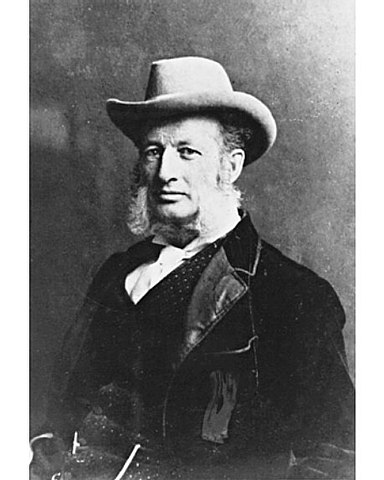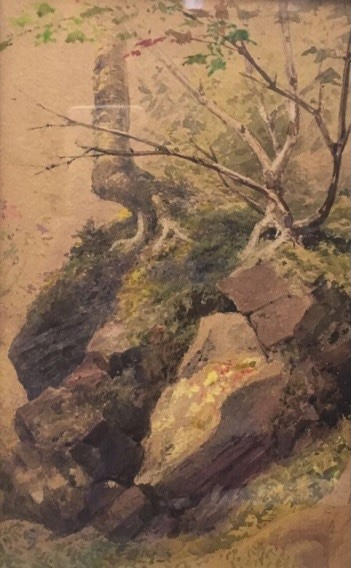By Trish Crowe-Grande, OMAH History Committee Chair

Lucius Richard O’Brien portrait undated
M.O. Hammond Collection: National Gallery of Canada Archives
Edward and Mary O’Brien
At the age of fourteen, Edward George O’Brien entered the naval service as a mid-shipman, but peace with America following the War of 1812 shattered his hopes of advancement in the navy. As a result, he entered the army to serve in the West Indies. However, due to poor health he left both the military and navy behind to come to Canada to start anew.
Arriving in Thornhill in 1829, Lieutenant Colonel O’Brien established himself as a half-pay officer and a permanent resident. The British Army and Royal Navy used the term half-pay officer during this time in reference to the pay or allowance an officer received when in retirement or not in actual service. However, they could be summoned back to their regiments if there was a sudden need for their services.
After arriving in Thornhill, O’Brien bought a farm in Vaughan Township and soon became a frequent visitor at the Gapper brothers’ (William and Richard) respective homes. This is where he met Mary Gapper, who had sailed from Bristol harbour in August of 1828, along with her mother, to pay a visit to her two brothers.
The intention was that Mary and her mother would help with the household for a short period and then return to England within the year. By 1829 Edward’s intention was clear and Mary had to decide whether to return to England or stay and marry him. Ultimately, she felt no reason to return to England, and on May 13th, 1830, Edward George O’Brien and Mary Sophia Gapper were married.
The O’Briens Move North to Kempenfelt Bay and Establish Shanty Bay
A year later they were sent northward to take charge of the half pay officers settled around Lake Simcoe. So began their life as settlers on the shore of Kempenfelt Bay whereupon in 1831, they established their homestead and a little community called “Shanty Bay.” The Government of Upper Canada, encouraged by Governor Sir John Colborne, bestowed land along the lake shore to retired British half-pay officers.
Colborne was concerned about protecting Upper Canada against any post-war American attacks. He conceived the plan to form a nucleus of trained personnel by encouraging them to take up land along the north shores of Lake Simcoe and the road to Penetanguishene. O’Brien was one of the first to obtain a land grant. Land grants were distributed in proportion to rank and services, with officers granted land along the shores of Lake Simcoe.
The O’Brien’s Contributions in Shanty Bay
The family experience was captured by Mary in her journals that were ultimately published in book format. Her intention with the journal, in the form of letters written to family back in England, was to share the flow of life in the rural townships of Upper Canada at the time, including the extreme difficulties. The log house built by O’Brien was known as “The Woods.” The couple were well respected in the community. Mary’s contributions to the community included delivering babies, nursing the sick and helping local children with their school lessons.
In the early years of settling in Shanty Bay, Edward was seen as a leader in the community, which included his appointment as superintendent of the Oro settlement and its magistrate, and the lieutenant-colonel of the local regiment. He founded two local churches, was instrumental in the founding of newspapers and in the formation of the only Canadian government-sponsored Black settlement in Oro Township.
The O’Brien Children
On top of their own contributions, Edward & Mary raised four children in Shanty Bay: William, Lucius, Henry & Lucy. They instilled in their children a sense of social responsibility with a strong foundation in both arts and science. Mary was devoted to the early education of her three sons, and they later received their formal education at Upper Canada College in Toronto.
The O’Brien sons became well-known for their respective careers with both William and Henry being called to the bar in 1861. William became the commanding officer of the 35th Battalion, Simcoe Foresters and was Muskoka’s Member of Parliament from 1882 to 1896. Henry became one of the most eminent corporate barristers of his day and was made a King’s Counsel in 1899.

Orillia Public Library
Lucius Richard O’Brien
Untitled Landscape, water colour signed, 9×5 ¼
Provenance: Gift by Dorothy Hale 1973
However, Lucius ensured he spent time enjoying nature and sketching. While living and working in Toronto, he started producing engraved works and he advertised as a drawing-master. Over the years he prepared drawings that were more of an architectural perspective for several Toronto engravers and lithographers. In 1854, he was employed as a drawing master at a Toronto girls’ school while continuing to exbibit his work and winning a few prizes along the way. His sketches included drawings done around Shanty Bay.
Lucius O’Brien – Orillia Councillor, Church Warden, Quarry Operator and Shop Owner
Around 1856, Lucius moved to Orillia to take over managing the family-owned quarry from his brother Henry, who had been advised by his father that it was time to move to Barrie to practice law. Lucius soon became involved in local politics, serving on the Orillia Council (1858-1861), as village reeve (1859-1861) and churchwarden at St. James (1859-61 and 1863-64). In 1866, Lucius married a local woman, Margaret St. John and he put aside his sketch book and founded a general store.

OMAH Collection
Title: “Canoe Pulled to Shore” 1875
Framed and Matted Watercolour Painting
Estate of Barbara Fallis
Lucius Returns to his Love of and Involvement in Art in a Big Way
Years later, in 1928, Henry recollected during an interview with the Orillia Packet & Times that before his brother Lucius took over the quarry from him that they did an inspection together. It was then that they met a Highlander Scot, working at the quarry, who played the fiddle while Lucius sketched away.
This may have been a key moment for Lucius to ultimately return to his sketchbook in 1868 and begin drawing scenes set around Orillia. Henry had in his possession during his interview with the Packet & Times, his brother’s sketchbook, which included scenes that reflected life in and around Lake Couchiching from that time period.
After travelling to Europe, Lucius returned to Toronto in 1870, and became active in Toronto’s art world, supporting the Ontario Society of Artists, becoming vice-president from 1874 to 1880. One of his significant contributions during this tenure was the establishment of the Ontario School of Art in 1876.
Lucius became acquainted with the new Governor General, Marquess of Lorne and helped organize the Royal Canadian Academy of Arts (RCA), serving as its first president in 1880. As part of this new Canadian academy was the establishment of a national gallery in which O’Brien contributed his work Sunrise on the Saguenay, which remains a prominent feature of the National Gallery of Canada’s collection.
The Marquess of Lorne also commissioned O’Brien to paint two pictures of Quebec City, which he did, and they now hang in Buckingham Palace. Along with this, O’Brien painted and taught in Toronto where he lived and worked in a large studio.
Due to his recent success, O’Brien could now paint full-time and had many artistic successes. These included being responsible for illustrating many of the drawings in “Picturesque Canada” (1882–1884), described as the most ambitious publishing project of the time (available in the Orillia Public Library collection). It aimed to celebrate Canada’s natural landscape united under Confederation. O’Brien was also chosen to be art editor for the project.
In 1890, Lucius retired from the RCA and opened his own art school, the “Studio Drawing Club,” travelled to Quebec to paint further and held exhibits in Toronto, Montreal and New York through to 1894, when he retired from the Ontario Society of Artists. He continued to teach privately between Barrie and Orillia and his last work was published in 1896.
By 1899 Lucius O’Brien became ill and no longer able to paint. He died in 1900 and was buried along with other members of the original O’Brien family at St. Thomas Anglican Church in Shanty Bay.
The O’Brien family’s contributions to the pioneering of our area are immeasurable. We are fortunate that Mary captured life in the backwoods and shared her family stories of life in the Lake Simcoe area in her diaries.
In addition, Lucius was an accomplished draftsman, architect, civil engineer, shopkeeper, politician but foremost he was recognized as an artist who specialized in capturing Canada’s disappearing wildlife and landscape in his paintings. In 1981, Lucius O’Brien was elected to the Orillia Hall of Fame.
We owe a debt of gratitude to the O’Brien family for their impact on our community and the important chronicling of the history of our area.
REFERENCES:
Books:
“A History of Simcoe County,” by Andrew F. Hunter © 1909; Reprinted © 1998.
“Kith ‘n Kin: Reminiscences, Biographies, Genealogies, Photographs of the Pioneer Families of the Township of Oro” © 1978. Edited by Joanna McEwen.
“The Journals of Mary O’Brien 1828–1838” ©1968. Edited by Audrey Saunders Miller.
“Picturesque Canada: The Country As It Was And Is”
Published 1882
Edited by George Munro Grant D.D. Queens University
Illustrated under the supervision of L.R. O,Brien , Pres R.C.A.
Documents:
Orillia Public Library Vertical File
“A Non-Agenarian’s reminiscences of Orillia and Lake Couchiching. An Interview with Mr. Henry O’ Brien” Orillia Packet & Times. March 15, 1928
Websites:
https://www.stthomasshantybay.com/church-history
https://www.gallery.ca/collection/artist/lucius-r-obrien
https://cowleyabbott.ca/artist/lucius-obrien
http://www.biographi.ca/en/bio/o_brien_lucius_richard_12E.html
https://www.thecanadianencyclopedia.ca/en/article/lucius-richard-obrien#
